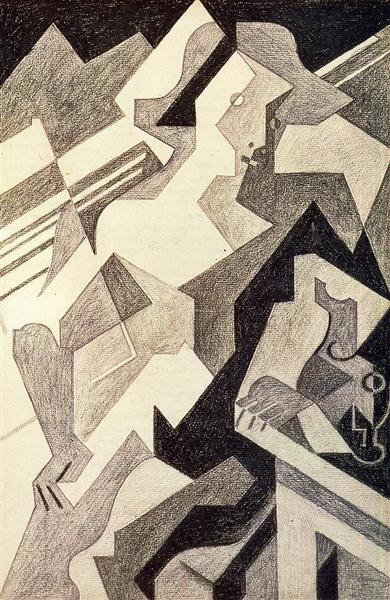Beschreibung
Die Arbeit "Arlequín auf dem Tisch" (1918) des spanischen Malers Juan Gris ist ein bemerkenswertes Beispiel für den reifen kubistischen Stil, der bei der Definition und Ausdehnung von Grey dazu beigetragen hat. In diesem Gemäld das Prisma des Kubismus.
Aus dem ersten Blick fühlt man sich sofort von der asymmetrischen und vielfältigen Disposition der Zusammensetzung angezogen. Der Harlequin, eine Figur, die traditionell mit Komödie und Theater verbunden ist, ist in einem Stil vertreten, der seinen spielerischen Charakter mit der Ernsthaftigkeit einer fast introspektiven Haltung verschmilzt. Die vorherrschenden Farben - grün, gelb und schwarz - werden in Mustern kombiniert, die sowohl ihre typische Harlequin -Kleidung als auch ein Gefühl der Tiefe und dreidimensionalität hervorrufen. Die Wechsel von Plänen und Linien erzeugt ein Gefühl von Bewegung und Vibration, das ein Merkmal des Kubismus ist, eine Bewegung, die die visuelle Realität zersetzen und wieder aufbauen wollte.
Die Figur des Harlekin ist nicht nur ein bloßes visuelles Ornament; Die Wahl dieses Charakters kann als Spiegelbild von Juan Gris selbst interpretiert werden, einem Künstler, der zwischen verschiedenen kulturellen und künstlerischen Welten reist. Der Harlequin, der oft als Botschafter des Spiels und der Transformation angesehen wird, kann auch auf eine Erforschung der Identität des Künstlers in einer Zeit radikaler Veränderungen und sozialer Spannungen nach dem Ersten Weltkrieg hinweisen. In diesem Sinne wird der Harlekin zu einer Metapher für die Dualität des zeitgenössischen Lebens: Spaß und gleichzeitig tragisch.
Die Tabelle, ein tägliches Objekt im menschlichen Leben, erhebt sich hier zu einem symbolischen Status; Es fungiert als Szenario, in dem nicht nur der Harlequin, sondern auch ein Spiel mit Lichtern, Schatten und chromatischen Frequenzen untergebracht sind, die es ermöglichen, die Beziehung zwischen der Figur und ihrer Umgebung zu untersuchen. Die Tabelle wird somit in einen Raum der Interaktion verwandelt, in dem Kunst und Leben konvergieren und zur visuellen Erzählung des Gemäldes beiträgt.
Gray verwendet einen streng analytischen Ansatz in der Struktur der Arbeit. Die Anordnung der Elemente auf der Leinwand und die Darstellung der Formen in miteinander verbundenen Ebenen verstärken die Konvergenz der Figur und des Hintergrunds. Dies führt zu einem ständigen Dialog zwischen dem zentralen Subjekt und dem Kontext, in dem er gefunden wird, was den Betrachter nicht nur mit dem Bild selbst, sondern auch mit der Beziehung, die mit dem Ort festgelegt ist, einbezieht.
"Harlekin auf dem Tisch" befindet sich in einem transformativen Moment des Lebens und der Kunst von Grau, als es sich zunehmend der Möglichkeiten des Kubismus bewusst war, komplexe und tiefe Emotionen mit fragmentierten Formen und einer koordinierten Palette zu erinnern. Im Vergleich zu anderen Werken der Zeit, wie den Gemälden ihrer Zeitgenossen Pablo Picasso und Georges Braque, fällt dieses Stück für seinen einzigartigen Ansatz in der menschlichen Figur und die Intimität der darstellten Szene auf.
Zusammenfassend ist das Werk von 1918 nicht nur ein Zeugnis von Juan Gris 'Virtuosität im Kubismus, sondern bietet auch eine reiche Meditation über die Dimensionen der Identität und der zeitgenössischen Interpretation des Lebens. Durch die Verwendung von Harlequin und seiner Umgebung schafft es Gris, eine visuelle Erzählung zu erstellen, die beim Betrachter mitschwingt, und lädt ihn ein, über die Komplexität des Seins in einer ständigen Veränderung nachzudenken. Das Gemälde mit seiner kühnen Mischung aus Farbe und Form bleibt ein Meilenstein in der Entwicklung der modernen Kunst und der Erforschung menschlicher Emotionen.
KUADROS ©, eine berühmte Farbe an Ihrer Wand.
Handgemachte Ölgemälde, mit der Qualität professioneller Künstler und dem unverwechselbaren Siegel von KUADROS ©.
Pictures Reproduction Service mit Zufriedenheitsgarantie. Wenn Sie mit der Nachbildung Ihres Gemäldes nicht vollständig zufrieden sind, erstatten wir Ihr Geld zu 100%.

